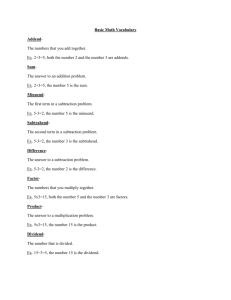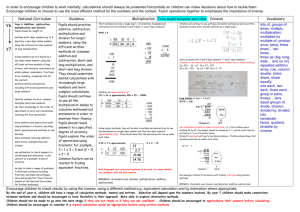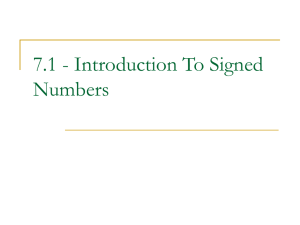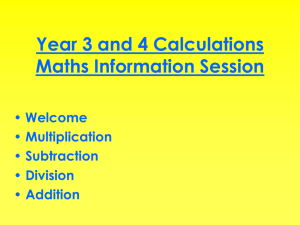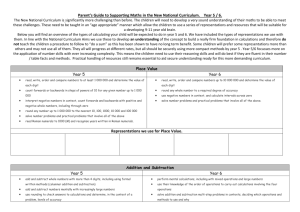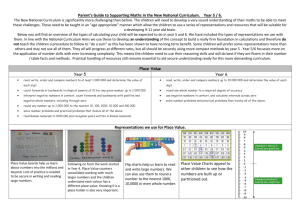Year 6 Addition and Subtraction
advertisement
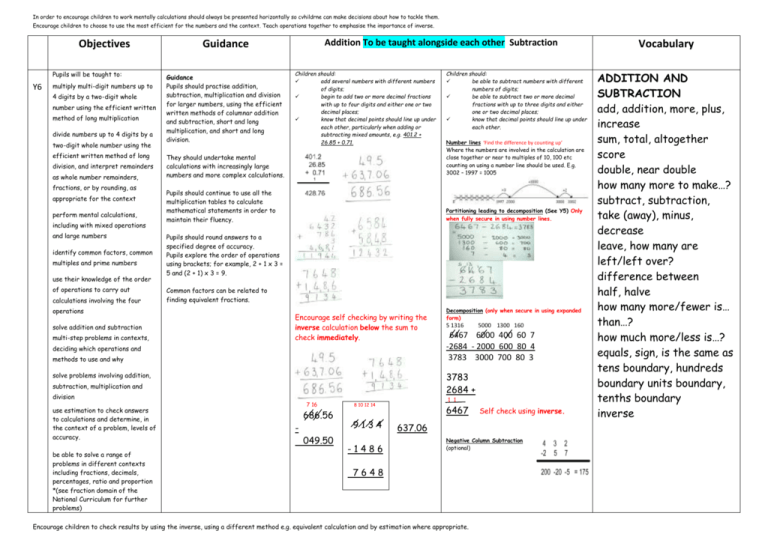
In order to encourage children to work mentally calculations should always be presented horizontally so cvhildrne can make decisions about how to tackle them. Encourage children to choose to use the most efficient for the numbers and the context. Teach operations together to emphasise the importance of inverse. Objectives Pupils will be taught to: Y6 multiply multi-digit numbers up to 4 digits by a two-digit whole number using the efficient written method of long multiplication divide numbers up to 4 digits by a two-digit whole number using the efficient written method of long division, and interpret remainders as whole number remainders, fractions, or by rounding, as appropriate for the context perform mental calculations, including with mixed operations and large numbers identify common factors, common multiples and prime numbers use their knowledge of the order of operations to carry out calculations involving the four operations solve addition and subtraction multi-step problems in contexts, Addition To be taught alongside each other Subtraction Guidance Guidance Pupils should practise addition, subtraction, multiplication and division for larger numbers, using the efficient written methods of columnar addition and subtraction, short and long multiplication, and short and long division. Children should: add several numbers with different numbers of digits; begin to add two or more decimal fractions with up to four digits and either one or two decimal places; know that decimal points should line up under each other, particularly when adding or subtracting mixed amounts, e.g. 401.2 + 26.85 + 0.71. They should undertake mental calculations with increasingly large numbers and more complex calculations. Pupils should continue to use all the multiplication tables to calculate mathematical statements in order to maintain their fluency. Pupils should round answers to a specified degree of accuracy. Pupils explore the order of operations using brackets; for example, 2 + 1 x 3 = 5 and (2 + 1) x 3 = 9. Common factors can be related to finding equivalent fractions. Encourage self checking by writing the inverse calculation below the sum to check immediately. methods to use and why subtraction, multiplication and division be able to solve a range of problems in different contexts including fractions, decimals, percentages, ratio and proportion *(see fraction domain of the National Curriculum for further problems) Decomposition (only when secure in using expanded form) 5 1316 5000 1300 160 6467 6000 400 60 7 -2684 - 2000 600 80 4 3783 3000 700 80 3 3783 2684 + solve problems involving addition, use estimation to check answers to calculations and determine, in the context of a problem, levels of accuracy. Number lines ‘Find the difference by counting up’ Where the numbers are involved in the calculation are close together or near to multiples of 10, 100 etc counting on using a number line should be used. E.g. 3002 – 1997 = 1005 Partitioning leading to decomposition (See Y5) Only when fully secure in using number lines. deciding which operations and Children should: be able to subtract numbers with different numbers of digits; be able to subtract two or more decimal fractions with up to three digits and either one or two decimal places; know that decimal points should line up under each other. 7 16 686.56 049.50 1 1 8 10 12 14 9134 -1486 6467 Self check using inverse. 637.06 Negative Column Subtraction (optional) 7648 Encourage children to check results by using the inverse, using a different method e.g. equivalent calculation and by estimation where appropriate. Vocabulary ADDITION AND SUBTRACTION add, addition, more, plus, increase sum, total, altogether score double, near double how many more to make…? subtract, subtraction, take (away), minus, decrease leave, how many are left/left over? difference between half, halve how many more/fewer is… than…? how much more/less is…? equals, sign, is the same as tens boundary, hundreds boundary units boundary, tenths boundary inverse In order to encourage children to work mentally, calculations should always be presented horizontally so children can make decisions about how to tackle them. Encourage children to choose to use the most efficient method for the numbers and the context. Teach operations together to emphasise the importance of inverse.
